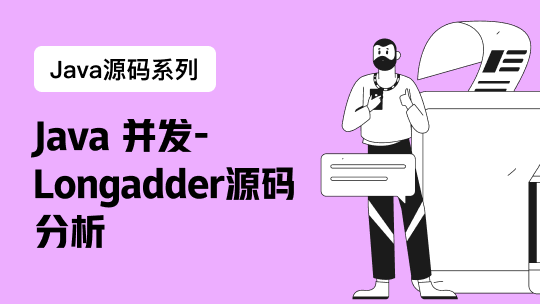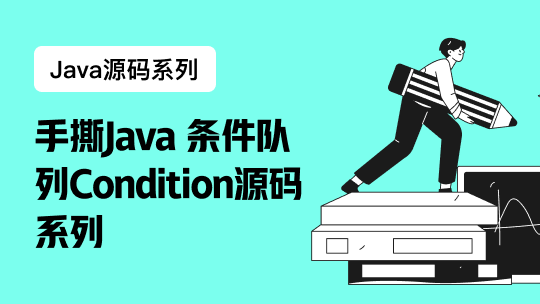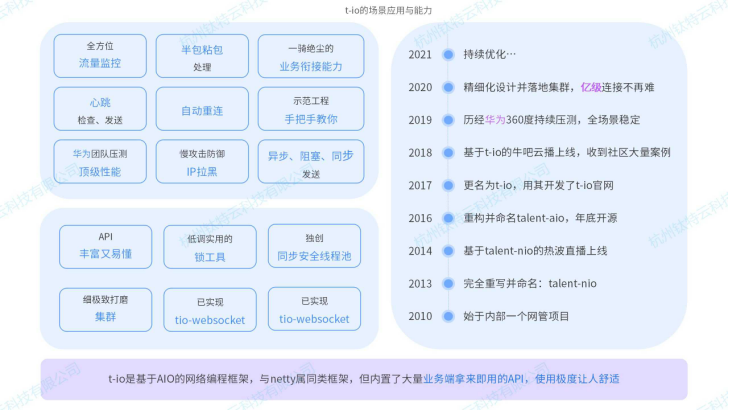本文讲述如何快速将 tio 服务整合到 SpringBoot 项目
首先,你需要在 pom.xml 中引入 tio-core-spring-boot-starter 构件
<dependency>
<groupId>org.t-io</groupId>
<artifactId>tio-core-spring-boot-starter</artifactId>
<!--此版本号跟着tio主版本号一致即可-->
<version>3.3.5.v20190712-RELEASE</version>
</dependency>
编写服务端程序
一、给SpringBoot Application 主类添加 @EnableTioServerServer 注解
@SpringBootApplication
@EnableTioServerServer
public class TioServerApplication {
public static void main(String[] args) {
SpringApplication.run(TioServerApplication.class, args);
}
}
二、接下来,修改配置文件
tio:
core:
server:
# websocket port default 9876
port: 6789
# 心跳时间
heartbeat-timeout: 60000
# 集群配置 默认关闭
cluster:
enabled: false
# 集群是通过redis的Pub/Sub实现,所以需要配置Redis
redis:
ip: 127.0.0.1
port: 6379
all: true
group: true
ip: true
user: true
# SSL 配置
ssl:
enabled: false
key-store:
password:
trust-store:
三、编写消息处理类
/**
* 消息处理 handler, 通过加 {@link TioServerMsgHandler} 注解启用,否则不会启用
* 注意: handler 是必须要启用的,否则启动会抛出 {@link TioMsgHandlerNotFoundException} 异常
*
* @author yangjian
*/
@TioServerMsgHandler
public class HelloServerMsgHandler implements ServerAioHandler {
/**
* 解码:把接收到的ByteBuffer,解码成应用可以识别的业务消息包
* 总的消息结构:消息头 + 消息体
* 消息头结构: 4个字节,存储消息体的长度
* 消息体结构: 对象的json串的byte[]
*/
@Override
public HelloPacket decode(ByteBuffer buffer, int limit, int position, int readableLength, ChannelContext channelContext) throws AioDecodeException
{
return PacketUtil.decode(buffer, limit, position, readableLength, channelContext);
}
/**
* 编码:把业务消息包编码为可以发送的ByteBuffer
* 总的消息结构:消息头 + 消息体
* 消息头结构: 4个字节,存储消息体的长度
* 消息体结构: 对象的json串的byte[]
*/
@Override
public ByteBuffer encode(Packet packet, GroupContext groupContext, ChannelContext channelContext)
{
return PacketUtil.encode(packet, groupContext, channelContext);
}
/**
* 处理消息
*/
@Override
public void handler(Packet packet, ChannelContext channelContext) throws Exception {
HelloPacket helloPacket = (HelloPacket) packet;
byte[] body = helloPacket.getBody();
if (body != null) {
String str = new String(body, HelloPacket.CHARSET);
System.out.println("收到消息:" + str);
HelloPacket resppacket = new HelloPacket();
resppacket.setBody(("收到了你的消息,你的消息是:" + str).getBytes(HelloPacket.CHARSET));
Tio.send(channelContext, resppacket);
}
return;
}
}
四、实现消息实体包
/**
* 消息包实体
*
* @author yangjian
*/
public class HelloPacket extends Packet {
private static final long serialVersionUID = -172060606924066412L;
public static final int HEADER_LENGTH = 4;//消息头的长度
public static final String CHARSET = "utf-8";
private byte[] body;
/**
* @return the body
*/
public byte[] getBody() {
return body;
}
/**
* @param body the body to set
*/
public void setBody(byte[] body) {
this.body = body;
}
}
接下来启动服务端
编写客户端程序
客户端采用 Tio 的常规程序启动,只有三个文件,启动非常简单。
一、编写常量类
public interface Const {
/**
* 服务器地址
*/
public static final String SERVER = "127.0.0.1";
/**
* 监听端口
*/
public static final int PORT = 6789;
/**
* 心跳超时时间
*/
public static final int TIMEOUT = 5000;
}
二、消息处理类
public class HelloClientAioHandler implements ClientAioHandler {
private static HelloPacket heartbeatPacket = new HelloPacket();
/**
* 解码:把接收到的ByteBuffer,解码成应用可以识别的业务消息包
* 总的消息结构:消息头 + 消息体
* 消息头结构: 4个字节,存储消息体的长度
* 消息体结构: 对象的json串的byte[]
*/
@Override
public HelloPacket decode(ByteBuffer buffer, int limit, int position, int readableLength, ChannelContext channelContext) throws AioDecodeException
{
return PacketUtil.decode(buffer, limit, position, readableLength, channelContext);
}
/**
* 编码:把业务消息包编码为可以发送的ByteBuffer
* 总的消息结构:消息头 + 消息体
* 消息头结构: 4个字节,存储消息体的长度
* 消息体结构: 对象的json串的byte[]
*/
@Override
public ByteBuffer encode(Packet packet, GroupContext groupContext, ChannelContext channelContext)
{
return PacketUtil.encode(packet, groupContext, channelContext);
}
/**
* 处理消息
*/
@Override
public void handler(Packet packet, ChannelContext channelContext) throws Exception {
HelloPacket helloPacket = (HelloPacket) packet;
byte[] body = helloPacket.getBody();
if (body != null) {
String str = new String(body, HelloPacket.CHARSET);
System.out.println("收到消息:" + str);
}
return;
}
/**
* 此方法如果返回null,框架层面则不会发心跳;如果返回非null,框架层面会定时发本方法返回的消息包
*/
@Override
public HelloPacket heartbeatPacket(ChannelContext channelContext) {
return heartbeatPacket;
}
三、客户端启动类
public class HelloClientStarter {
//服务器节点
public static Node serverNode = new Node(Const.SERVER, Const.PORT);
//handler, 包括编码、解码、消息处理
public static ClientAioHandler tioClientHandler = new HelloClientAioHandler();
//事件监听器,可以为null,但建议自己实现该接口,可以参考showcase了解些接口
public static ClientAioListener aioListener = null;
//断链后自动连接的,不想自动连接请设为null
private static ReconnConf reconnConf = new ReconnConf(5000L);
//一组连接共用的上下文对象
public static ClientGroupContext clientGroupContext = new ClientGroupContext(tioClientHandler, aioListener, reconnConf);
public static TioClient tioClient = null;
public static ClientChannelContext clientChannelContext = null;
/**
* 启动程序入口
*/
public static void main(String[] args) throws Exception {
clientGroupContext.setHeartbeatTimeout(Const.TIMEOUT);
tioClient = new TioClient(clientGroupContext);
clientChannelContext = tioClient.connect(serverNode);
//连上后,发条消息玩玩
send();
}
private static void send() throws Exception {
HelloPacket packet = new HelloPacket();
packet.setBody("hello world".getBytes(HelloPacket.CHARSET));
Tio.send(clientChannelContext, packet);
}
}
启动客户端端,查看终端输出。
服务端输出

原生回调接口支持
跟 handler 一样,其他原生回调接口的使用方法保持不变,只需要在对应的实现类上加上对应的注解就 OK 了。
//最主要的逻辑处理类,必须要写,否则抛异常
public class HelloServerMsgHandler implements ServerAioHandler {}
//可不写,通过加 @TioServerAioListener 注解启用,否则不会启用
public class HelloServerAioListener implements ServerAioListener {}
//可不写, 通过加 @TioServerGroupListener 注解启用,否则不会启用
public class HelloServerGroupListener implements GroupListener{}
//可不写,通过加 @link TioServerIpStatListener 注解启用,否则不会启用
public class HelloServerIpStatListener implements IpStatListener {}
这里注意:每个对应的回调接口都需要通过添加注解手动启用,否则默认不启用,不会自动扫描
服务端主动推送
这个也非常简单,只需获取到 TioServerBootstrap ,其他都变得非常简单。
@RestController
public class HelloController {
static Logger logger = LoggerFactory.getLogger(HelloController.class);
@Autowired
private TioServerBootstrap bootstrap;
@GetMapping("/")
public String index()
{
return "Hello, tio-spring-boot-starter !!!";
}
/**
* 推送消息到客户端
* @throws Exception
*/
@GetMapping("/push")
public String pushMessage() throws Exception {
HelloPacket packet = new HelloPacket();
packet.setBody("This message is pushed by Tio Server.".getBytes(HelloPacket.CHARSET));
Tio.sendToAll(bootstrap.getServerGroupContext(), packet);
logger.info("Push a message to client successfully");
return "Push a message to client successfully";
}
}
客户端输出截图

SSL 支持
# SSL 配置
ssl:
enabled: true
key-store: key-store path
password: password
trust-store: trust-store path
集群支持
# 集群配置 默认关闭
cluster:
enabled: false
# 集群是通过redis的Pub/Sub实现,所以需要配置Redis
redis:
ip: 127.0.0.1
port: 6379
all: true
group: true
ip: true
user: true








